 Tech Notes: – History of the GE 5670 Tube The (5670) electron valve. It. Matters.
Tech Notes: – History of the GE 5670 Tube The (5670) electron valve. It. Matters.Every audio aficionado likes 'em electron valves and for a number of reasons. The two most obvious ones are their influence on the sound itself and highly appealing aesthetics. Some of you might dislike the look of glowing glass and since this matter is highly subjective one, we won't focus on it. The rest though, well, that's a completely different story.
Our latest headphone amplifier - the Pro iCan - is loaded with a pair of GE5670 JAN double triodes. OK, there's a ton of valves out there. Therefore, this question is in order: why do we use this one specific type from this specific manufacturer? Now that's a story to be told. Here we go then.
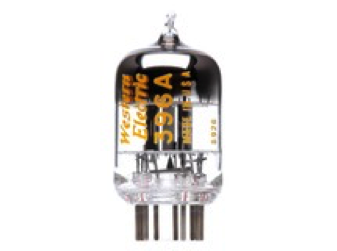
Behold the WE396A double triode by Western Electric. These small critters were introduced in 1946 and shortly replaced by their 6922 variants. The former is the pinnacle, almost unfindable these days. The scenario isn't that grim when it comes to the latter type. But as it turned out, there is one sonically as good model and made to very strict specifications - the GE JAN 5670 NOS type. It was under the radar of the audiophiles' scope for many years.
GE stands for General Electric, the manufacturer, which is self- explanatory. Said company was responsible for electron valves production for decades and is well-known for the quality of its products.
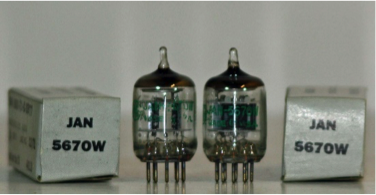
Moving on, JAN is the service branch of the US Armed forces and said three letters stand for Joint Army & Navy. Electron valves marked as JAN were made for the Army/Navy (the Airforce had to have their own naturally) and had to pass the most rigorous testing procedures at that time.
The Russian parallel system was OTK, which means "Отдел технического контроля" or technical control department. Even the Russian system was very decent as one does not wish for Mach 3 Jet Fighters at 100 million rubles a pop to be falling out of the sky on account of poor electron valves. This translated into modern money would be ~350 Million USD - the same as the F-22 Raptor today! And yes, it used electron valves for a lot of critical electronics.
 Fun notes on the Mig-25 ‘Foxbat’:i.
Fun notes on the Mig-25 ‘Foxbat’:i. This Mach 3+ jetfighter, that scared the living daylights out of the USAF and inspired the movie ‘Firefox’ with the Clint Eastwood, was no cheap pile of junk (even if it was not as rad as the Firefox).
ii. The unit cost was around 100 million Rubles in the mid 70's - in modern money that would be around 350 Million USD - the same as the F-22 Raptor today! And yes, it used electron valves for a lot of critical electronics.
iii. It packed a targeting radar so powerful it was a crime to even turn it on except in combat or exercise. It would kill small mammals at several 100 feet (microwaved to death!!!).
iv. Last fun fact - when the Israeli Air Force radar clocked Egyptian MIG-25's doing reconnaissance over the Sinai in 1973 (Yom Kippur War) at Mach 3.2, they thought their radar was broken!
Germany/Europe never had an equivalent system, they got either JAN electron valves with US equipment (including export versions) or German Postal electron valves (CCa, C3g, D3a etc.) made in...Germany.
The British Empire had (surprisingly) its own inter-service system for military electron valves, it came into force in 1941. The British generally used civilian electron valves (and later transistors) that were tested and certified for military use. British Military electron valves are identified by the letters CV (Common Valve) and a number.
Generally JAN/OTK marked electron valves are more rugged, have very tight technical parameters and much less variation, and yet, are at the same time compatible with civilian types. German/European Postal electron valves in general were dedicated designs with the singular exception of the Cca and equally ruggedised. British and Chinese used selected (or not) civilian electron valves for military applications.
In many ways the 5670, when introduced, was a revolutionary electron valve. Ostensibly an RF device for VHF use, thanks to a usable frequency range to 800MHz it also offered good linearity, low harmonic distortion and low-noise in audio applications. Yet the 5670 electron valves never really went into audio gear much. Why?
First, being a relatively expensive electron valve to make made them less attractive for mass production.
Second, they saw wide military equipment use, including fire control computers and communication systems.
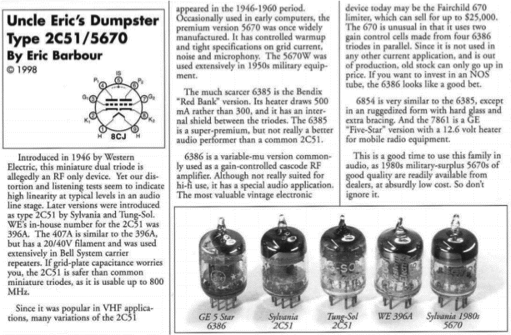
So, before the late 80's the US Military & Nato stockpiled most of the production. Production of the 5670 ended in the 1980’s almost completely, so stockpiles were retained until the equipment they supported was removed from inventory in the latter part of the 90’s.
Third, and in addition, the 5670 uses a non-standard pinout. If one looks at 12AX7, 12AU7 or 6DJ8/6922, all of these have an identical or very similar pinout. The 5670 pinout is radically different. Electrically and in terms of internal design it is very similar to the 6DJ8/6922 which became very popular in American high end audio gear, but one can't plug it into a 6922 socket.
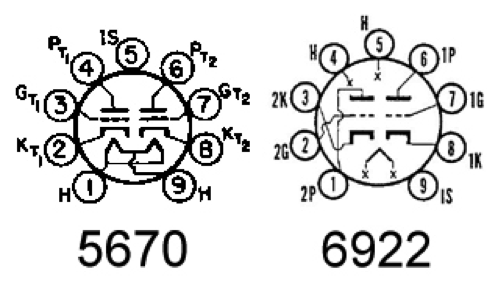
Well, physically it's doable, mechanically the 5670 will plug into a 6922 socket, yet the result may be deadly for the Preamplifier/Amplifier as heater and anode pins are mixed up, shorting out the high voltage power supply. Just don’t go there girlfriend.
Now let's add the price factor to the mix. Military parts always cost at least 10 more in comparison to identical civilian parts. Which for 5670 model meant that no-one designed audio gear with these electron valves during the golden age of Valve Audio.
After the military blew out these stocks from their warehouses when the cold war ended (those cavernous places like the one shown at the end in Indiana Jones "Raiders of the Lost Ark")...

...still very few people used them, as they couldn't be plugged into existing gear due to the non-standard pin-out. Long story short, NOS 6922 became very popular and their rare cousins worth 100's of Dollars while no-one wanted the 5670.
For the last 25 years plus dealers and audiophiles have been depleting very limited 6922 NOS stocks and that's why today it is next to impossible to find decent electron valves of this sort. And what about the unloved but excellent 5670? It sat nice and snug in warehouses like the proverbial Ark of the Covenant waiting for someone to discover it. That would be first of all Eric Barbour of Vacuum Tube Valley Magazine (but his article was also widely ignored) and then us.
5670 valves became somewhat popular when Shanling made CD-players and electron valve amps years back which used the Chinese 6N3, a Chinese copy of the soviet 6N3P (often incorrectly written as 6H3PI) which was the Soviet version of the 5670. As few people knew about the possibility to swap the 5670 for a 6N3 the good stuff mostly remained in storage.
Needless to say, now the 5670 cat is out of the bag as a workable NOS 6922 substitute, AMR/iFi Audio have bunkered the content of one of these military warehouses for future use. With either the correct socket wiring (which our Pro iCAN sports) or an adapter (like used for our NOS 6922 replacement) they will be hunted to extinction within a few years by all the ‘electron valve hounds’ of audiophilia... Grab 'em while you can.

So there you have it, GE JAN 5670 NOS is a marvelous piece of glass built to last (100,000 hours’ of lifespan are easily possible if the electron valve is operated conservatively), with marvelous sound quality. The very best among what's currently available for the money. Yes, you can go even higher. But it's not only just an expensive journey to be had; the money is the smallest issue actually.
The main problem is in availability and origin of the various Western Electric & Bendix 6N3 equivalents. Yes, counterfeits are out there, you've been warned.
Glass going on recordMakers of 5670/2C51/ECC40 on record: (we are not going to do a sonic ranking between the valves in each category - waaay too subjective).
Best• WE USA (as 396A) (there are D and O getter versions) - probably the best of the lot but good luck in finding original 'good' ones from reputable sellers for £££
• Bendix USA (as 6385) - very rare and hyper expensive
• GE 5670 USA - as used in AMR CD 777 SE/DP-777SE & iFi Pro Series/Tube2/iTube
Middle• Raytheon USA
• Tung Sol USA
• Old Soviet 6N3P-EV OTK marked Stock
Worst• Soviet Russia 6N3P civilian type (marked in Cyrillic so looks like 6H3П)
• China (as 6N3)
The 5670/2C51 has similar data and application as the later European ECC88 and variants, so European valve makers concentrated on that type of valve. Some valves marked "England" have been sighted, these appear mostly remarked Russian units.
Sylvania also made a 5670 which was also seen remarked as ‘Mullard’ but it isn't a true Mullard as they never made this version of valve, just a rebranding job.
With the AMR CD/DP-777 SE or iFi iCAN Pro/iTube/iTube2/NOS 6922, we would not spend our hard earned cash on anything but the WE396A or Bendix USA.
Note 1 - some background, the 5670/2C51 from a technological point of view, the "premium version" of the 6922electron valve. Better design, strong plates, lower microphonics etc etc... So if you have the 6922, you can roll the valves in your non-iFi device and get better sonics but with the 5670/2C51 family using adapters, you are already running with the big guns.
Note 2 - the 5670 and 6922 have the same physical pins but are not directly interchangeable as they different fundamental designs.
The AMR CD/DP-777 SE use 6922 Pinout and adapters to convert the 5670 to 6922 pinout, so both 6922 and 5670 with adapter can be used. The iFi iCAN Pro/iTube/iTube2 have the sockets wired only for 5670, you cannot insert a 6922.
Moving on, one might think that if magnificent 5670 electron valves as we use in our product are quite available, then something's off. But that's not the case. As we've said above, this electron valve has ‘flown’ under the radar for many years, 6922 and alike were much more popular. Yet popularity isn't an indication of what's good.
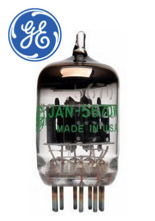
From a purely technical side, GE JAN 5670 NOS valves are the best ones we could find in large batches enough to be commercial.
1. Excellent consistency of electron valves between batches
2. Glass is thicker than usual,
3. Controlled warm-up
4. Tight specifications on grid current,
5. Low noise and microphonics and exceptional longevity

And since genuine military grade New Old Stock 5670electron valves are reasonably well available (unlike many desirable electron valves), it'd be a shame not to exploit their potential. Hence we exploit as much as we can, fully aware of what GE JAN 5670 NOS performs and sounds like.
At iFi Audio we always strive to find the best parts for tasks given. This is not lip service – we ruddy well mean it!
We experiment with lots of components from a number of manufacturers, measure, audition and once extensive research is gathered, we cherry-pick. If every component’s related decision would be as simple as it was with GE JAN 5670 NOS, our engineering lives would be much easier and we’d spend a lot more time in the pub!
In conclusion, this electron valve has an incredible price-to-performance ratio, it honestly doesn't get much better than this. We've been there, we've done that – we’ve got the t-shirt and the blinking key ring.

You're of course free to experiment with our Pro iCAN past warranty period. But it's highly unlikely that you'll find anything better for sane money. Please trust us on this one; our Skin, she does not joke around when it comes to sound quality.
Take a look at our NOS 6922.
http://ifi-audio.com/portfolio-view/accessory-nos-6922-2/